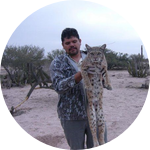About This Project
Geothermal stations cause emissions of pollutants into the environment and can cause damage to living organisms. We believe that spider communities can be used to measure the damage of pollutants in these areas. We hypothesize that the diversity and abundance of spiders near geothermal plants is less diverse and less abundant when compared to the spider diversity and abundance at non-exploited geothermal potential sites.
Ask the Scientists
Join The DiscussionWhat is the context of this research?
Geothermal energy is a source of renewable energy that results from the heat of the earth and is located in hydrothermal systems. The first geothermal plant in Mexico began operating in 1959; and there are now 38 geothermal plants in the country. Despite being a source of clean energy, geothermal causes emissions of pollutants into the environment. For this reason, the environmental impact caused by the production of this type of energy must be evaluated. We measure the biodiversity and richness in spider communities. By measuring the biodiversity and richness in spiders near geothermal energy sources and comparing that to spiders in non-geothermal energy source environments we can determine if spiders can be used as bioindicators for environmental pollution.
What is the significance of this project?
A good option to monitor the contamination levels of an area is the use of bioindicators. Spiders can become good bioindicators of contamination due to their resistance and regulation to heavy metals, are an important portion of species richness in the ecosystem, are cheap and easy to sample, and as predators can accumulate pollutants through biomagnification. For these reasons, we believe that they can become good bioindicators of environmental contamination and if we can successfully use spiders as bioindicators for geothermal sites, then this leads to to their application in the environmental impact studies of future geothermal energy projects.
What are the goals of the project?
Our hypothesis is that diversity and abundance of spiders near geothermal plants is less diverse and less abundant when compared to the spider diversity and abundance at non-exploited geothermal potential sites.
To test our hypothesis, 12 random points were selected in each study site where the spider samplings were carried out. With the data obtained, the abundance, richness and diversity will be calculated, also a t-test will be carried out to determine differences in the diversity of species between the two sites.
To verify the difference between the environmental variables of the sites and the relationship between the species with these variables, an ANOVA test, a similarity analysis and a canonical correspondence analysis will be carried out.
Budget
Currently a first trip to the study site was made, this was possible with external and own resources.
No field samplings of spiders were done because the resource was not available to buy the necessary materials.
With the resources obtained it is planned to make this second trip and buy materials to carry out spider samplings in the two study sites for which twelve sampling points were chosen distributed in the four environmental units that are pine forest, grassland, agricultural area and scrub, as well as laboratory tests that will be carried out once we return to the university.
Endorsed by
 Project Timeline
Project Timeline
The trip to Puebla, Mexico will aim to conduct a field sampling at the 12 sampling points of the four environmental units of each site and then return to the University of Baja California in Ensenada, Mexico to perform chemical analysis, taxonomic identification and analysis. statistical data to complete the work.
Then I will publish this research in a scientific journal and defend my thesis to obtain a master's degree in ecosystem management.
Aug 30, 2018
Start of sampling
Sep 17, 2018
Project Launched
Oct 01, 2018
Travel to Puebla, México and begin sampling.
Nov 30, 2018
End of sampling spiders
Dec 03, 2018
Taxonomic identification of the samples
Meet the Team
Affiliates
Affiliates
Affiliates
Affiliates
Team Bio
The team is formed by Guillermo Romero who has a PhD in wildlife management, by Jesus Rodriguez biologist from the University of Guadalajara who has extensive fieldwork experience, by Kristal Gonzalez who has a experience work with flora and by Luis Carlos Hernandez biologist from the Autonomous University of Baja California, who is an expert in spiders, together we make a great team to achieve the objectives of the project both in the field and in the laboratory.
Luis Hernandez
I graduated from the Autonomous University of Baja California in 2016 with a BSc in Biology. Later, I started to study an MSc in ecosystem management in the same institution. I am currently studying a PhD in Centro de Investigación Científica y de Educación Superior de Ensenada.
My research topic focuses on the use of spiders as bioindicators, although I have also worked on issues of arachnid biodiversity and public health impact issues, especially in the area of science dissemination in the city where i was born, Ensenada, Baja California, Mexico.
Krystal L. González Estupiñán
I studied biology in the University of Guadalajara, from 2006 to 2011. Then I studied a specialty in environmental science, management and sustainability at the University of Colima, from 2015 to 2016. In 2017 I began a Master degree at the Autonomus University of Baja California.
Jesús Rodríguez
I graduated from University of Guadalajara with a BSc in Biology in 2012. In 2017 I finished an enviromental sciences, management and sustainability specialty program from University of Colima. In 2018 I started a MSc program in ecosystem management inthe Autonomous Universiry of Baja California. Since I started my professional career I have loved working with animals, plants and fungi. However amphibians and reptiles became my main study object; I have worked with crocodiles, venomous snakes and sea turtles, but all mexican herpetofauna is my pasion. I have had the opportunity to work in different states such as Jalisco, Colima, Nayarit, Oaxaca, Veracruz, Coahuila, Baja California Sur and Baja California. Most recently I had the opportunity to expand and work with birds and mammals as well.
Guillermo Romero-Figueroa
I obtained my first PhD in natural resource management in the center of Biological research of the northwest (CIBNOR) and in 2013 I got my second PhD in wildlife at the Universidad Autónoma Agraria Antonio Narro.
From 2012 to 2013 I worked as an associate researcher at the Institute for Conservation Research of the San Diego Zoo, and since 2014 I work as a professor and researcher at the Autonomous University of Baja California, Mexico in the science department.
I work mainly with topics on wildlife management, ethology and conservation biology.
Project Backers
- 8Backers
- 26%Funded
- $383Total Donations
- $47.88Average Donation



